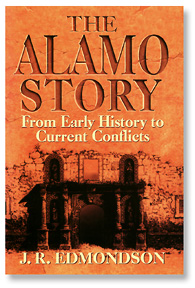
![]()

![]()
The Alamo Story: From Early History to Current Conflicts
by J. R. Edmondson
Republic of Texas Press
Plano Texas, 2000
$24.95. 439 pages
including a bibliography and index
with maps and illustrations.
Roughly once a decade, a new book comes along about the Alamo. In 1948, it was The Alamo by John Myers Myers. Lon Tinkle's 13 Days to Glory followed in 1958. After that, came Walter Lord's A Time To Stand in 1961, which became a standard for many years. In 1990, twenty years after Walter Lord's publication, Jeff Long gave us his interpretation of the Alamo legend with Duel of Eagles, a well-written, well-researched book. However, its negative slant largely invalidated its usefulness. Albert A. Nofi wrote The Alamo and the Texas War for Independence in 1992, but it added little new information to the story.
J. R. Edmondson's The Alamo Story, is this century's first full-length treatment of the Alamo. It may replace A Time To Stand as the new definitive work on the Alamo. Since 1961, new information has come to light, of which Edmondson makes good use. In some areas, his conclusions, and interpretations, may differ from those of other historians. However, The Alamo Story is a masterful telling of the saga.
Edmondson divides The Alamo Story into four parts.
Part One: The Mission
This section tells of the founding of the Alamo mission, the early history of Texas, Hidalgo's revolution, and the Battle of the Medina.
Part Two: Gone to Texas
Edmondson conveys information about the men who would figure prominently in the history of Texas, Stephen Austin, Santa Anna, and James Bowie.
Part Three: Revolution
The author recounts the troubles at Anahuac, the Battle of Gonzales, the Siege & Battle of Béxar, and the misguided movement against Matamoros. He also introduces us to William Barret Travis, Sam Houston, and David Crockett.
Part Four: Thirteen Days
This section narrates the story setting aside a chapter for each day of the siege. Each chapter places the siege in context with those things that happened elsewhere on that particular day. Edmondson keeps us informed of the occurrences at Goliad and Gonzales and of the situation at Washington-on-the-Brazos. It was there a convention met that ultimately decided whether the men of the Alamo fought for an independent nation, or an independent state within Mexico.
At the end of each of the four parts, is a section, "Myths, Mysteries, and Misconceptions." Edmondson skillfully uses this device to wrestle with questions such as the invention of the Bowie knife, why Travis went to Texas, the number of Texian casualties, and whether any Texians tried to escape. The Alamo Story ends with an epilogue, examining the battles that continue to this day, over the interpretation of the Alamo story.
Footnotes are the only things I missed in The Alamo Story. Edmondson provides the majority of his sources within the text of the book, but there are a few quotations that were new to me, and he did not identify. That is the only fault I could find in a great book, one that everyone interested in the Alamo should add to his bookshelf.
Robert L. Durham, Contributing Editor
Alamo de Parras
![]()